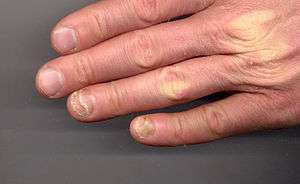Onycholysis
| Onycholysis | |
|---|---|
 | |
| Left hand onycholysis: ring and little fingers affected | |
| Classification and external resources | |
| Specialty | dermatology |
| ICD-10 | L60.1 |
| ICD-9-CM | 703.8 |
| DiseasesDB | 9236 |
| MeSH | D054039 |
Onycholysis /ˌɒnᵻˈkɒlɪsɪs/ refers to the detachment of the nail from the nail bed, usually starting at the tip and/or sides.[1] On the hands, it is said to occur particularly on the ring finger but can occur on any of the fingernails. It may also happen to toenails.
Onycholysis can occur in many conditions, including psoriasis.[2] In thyrotoxicosis it is thought to be due to sympathetic overactivity.[3] It may also be seen in infections or trauma.[4]
Etymology
Onycho-, from Ancient Greek ónuks, meaning nail, and Ancient Greek lúsis, meaning a loosening.
Causes
- Idiopathic
- Trauma, excessive manicuring
- Infection: especially fungal
- Skin disease: psoriasis, dermatitis
- Impaired peripheral circulation e.g. Raynaud's
- Systemic disease: hyper- and hypothyroidism, reactive arthritis, porphyria cutanea tarda
- Sometimes a reaction to detergents (e.g. washing dishes with bare hands, using detergent-based shampoos or soaps).
- Patients with hepatocellular dysfunction may develop hair-thinning or hair loss and nail changes such as clubbing, leukonychia (whitening), or onycholysis, affecting the nails of the hands and feet.[5]
See also
References
- ↑ Freedberg; et al. (2003). Fitzpatrick's Dermatology in General Medicine (6th ed.). McGraw-Hill. p. 660. ISBN 0-07-138076-0.
- ↑ Dennis, Mark; Bowen, William Talbot; Cho, Lucy (2012). "Onycholysis (Plummer's nail)". Mechanisms of Clinical Signs. Elsevier. p. 542. ISBN 978-0729540759; pbk
- ↑ Talley&O'Connor (2006). Clinical Examination A Systematic Guide to Physical Diagnosis (5th ed.). Elsevier. p. 262. ISBN 0-7295-3762-5.
- ↑ Weber&Kelley (2010). Health Assessment in Nursing (4th ed.). Wolters Kluwer Health and Lippincott, Williams & Wilkins. p. 193. ISBN 978-0-7817-8160-2.
- ↑ Hazin, Ribhi; Tamimi, Tarek I. Abu-Rajab; Abuzetun, Jamil Y.; Zein, Nizar N. (October 2009). "Recognizing and treating cutaneous signs of liver disease". Cleveland Clinic Journal of Medicine. 76 (10): 599–606. doi:10.3949/ccjm.76A.08113. ISSN 0891-1150. PMID 19797460.
This article is issued from Wikipedia - version of the 12/1/2016. The text is available under the Creative Commons Attribution/Share Alike but additional terms may apply for the media files.